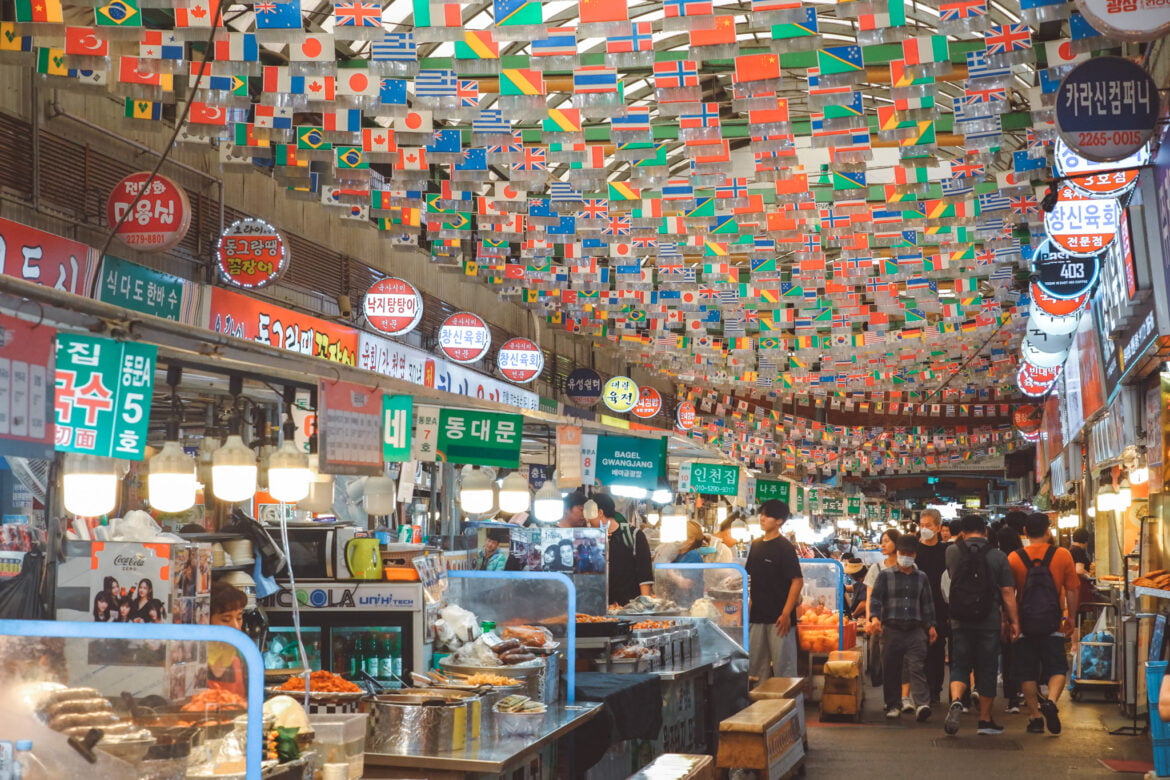Gwangjang Market (광장시장) is a bustling hub of commerce in Seoul, South Korea. The market has been around since 1905, and it’s home to over 5,000 vendors, making it one of the oldest and largest traditional markets in the country. The market is famous for its textiles, traditional Korean goods, and most importantly, its street food. I rarely recommend my friends to visit those highly hyped tourist spots. But when it comes to Gwanjang Market, I never fail to at least not boast about its unmissable food to try. Even me myself never stops swinging every once in a while because my taste buds keep asking for more of the genuine flavors of the Korean cuisine only found here inside this very bustling market.
If you’re planning a visit to Gwangjang Market, you’re in for a real treat. In this post, we are going to present you the best foods to try and where to find them in the market.
Gwangjang Market Operating Hours:
Before delving into the food offerings, it’s worth noting that Gwangjang Market welcomes visitors daily from 9:00 AM to 6:00 PM. While the clothing stores within the textile alleys observe a weekly closure on Sundays, the delectable variety of street food in the eating alleys remains accessible, as most food stalls continue to serve on Sundays.
However, it’s important to note that individual food stall schedules may vary. Some stalls might open outside the market’s regular hours, while others might be closed during specific periods. Notably, the renowned Netflix lady’s stall shuts its doors on Mondays and the 4th Sunday of each month.
When is the Best Time to Visit the Food Alley?
For the liveliest experience within the market, I would suggest visiting the Food Alley on weekdays when the market operates regularly, offering a wide array of shops and stalls to explore. However, if you prefer a more relaxed atmosphere with fewer crowds, consider visiting Gwangjang Market on Sundays. During this time, you can leisurely navigate the food street without the hustle and bustle. You’ll find shorter lines and fewer visitors at popular spots like the twisted donut shop, the Netflix lady’s restaurant, Chong-Gagne Bung-Eoppang, and many other stalls!
Now that you’re aware of the opening hours, let’s explore the mouthwatering delights that Gwangjang Market has to offer:
Bindaetteok | 빈대떡
Type: Snack/Side Dish
Prices/piece: 4,000KW~5,000KW
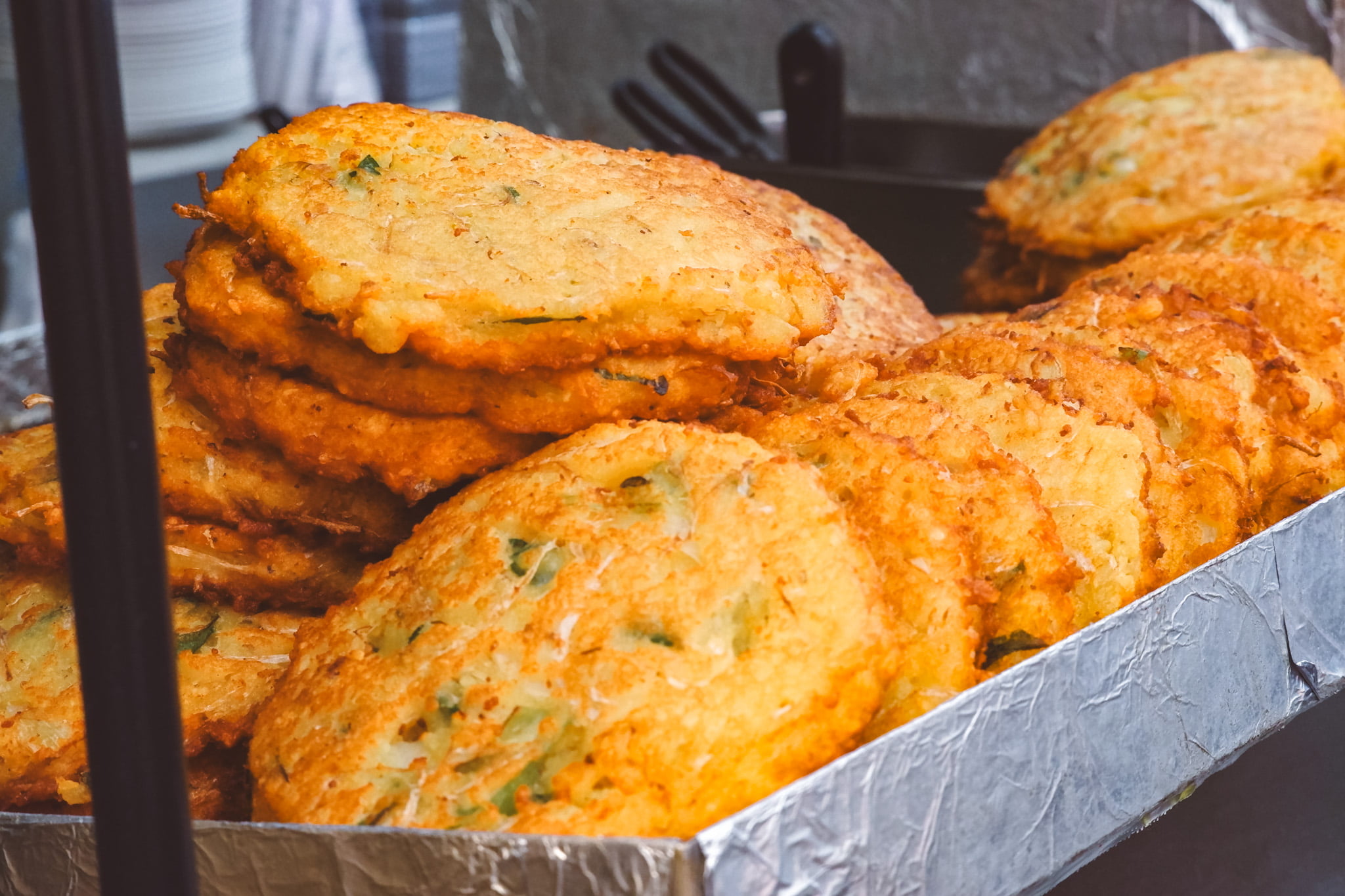
Bindaetteok, also known as mung bean pancakes, is a highly sought-after snack and side dish in Gwangjang Market. These savory pancakes are created by blending ground mung beans with an assortment of vegetables and occasionally meat. They are then expertly fried to achieve a delectable crispiness. If you’re looking to indulge in this popular street food, here are a few establishments on the Naver platform that have received stellar reviews for their bindaetteok:
Recommended Bindaetteok Places:
Mayak Gimbap | 마약김밥
Type: Snack
Prices/5~7 piece: 3,000KW~5,000KW
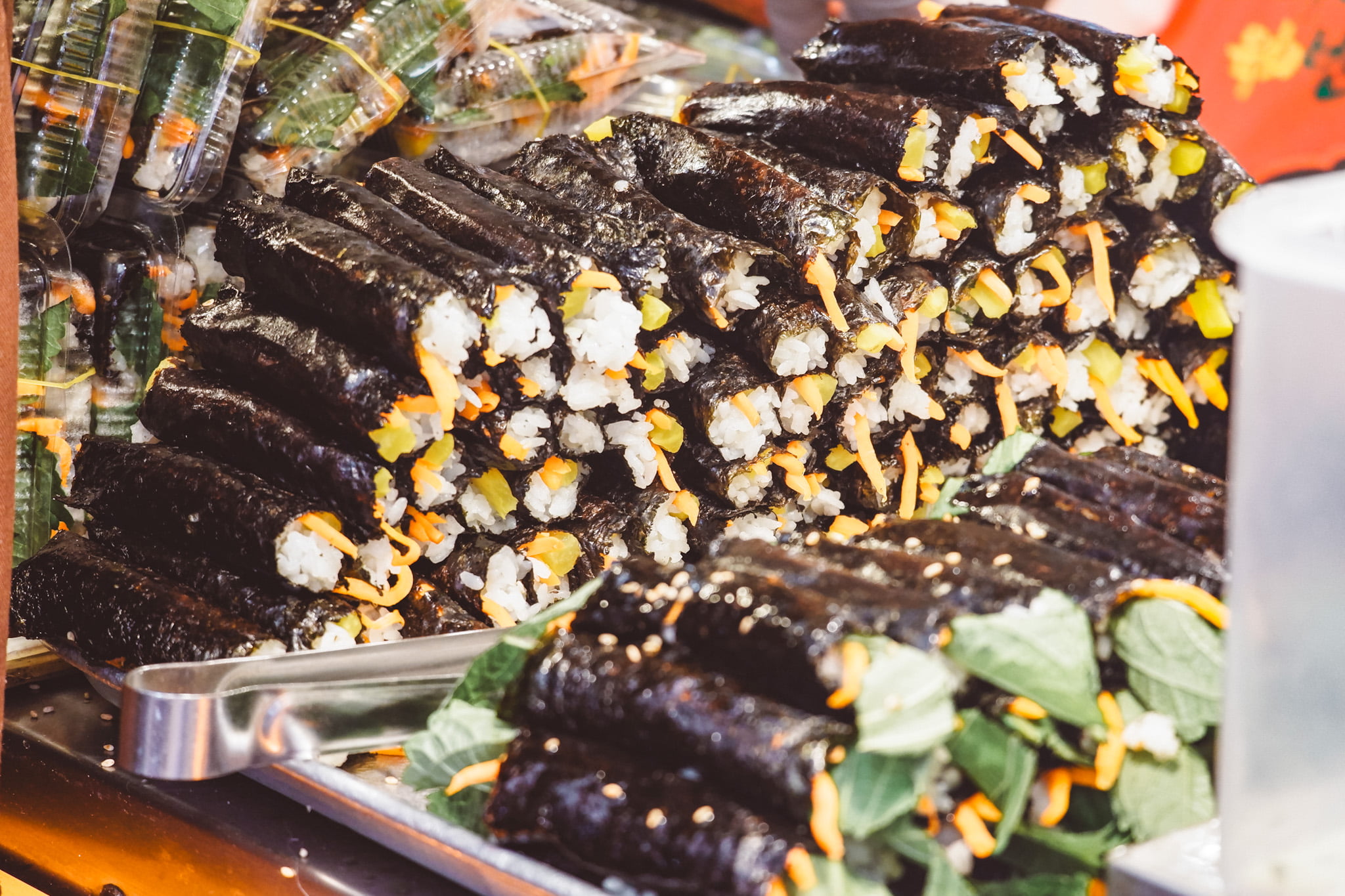
Resembling sushi rolls, this delightful treat consists of rice, vegetables, and occasionally meat, all tightly wrapped in seaweed and sliced into small, bite-sized pieces. Unlike regular gimbap, Mayak Gimbap features thinner filling layers and a smaller size, making it an ideal option for a light meal. It pairs well with a wide variety of foods, allowing you to enjoy it alongside any dish you desire. Personally, I find it particularly delicious when paired with a plate of Yukhoe, a tantalizing dish of sweet marinated raw beef (continue reading to learn more about its appearance).
Recommended Mayak Gimbap Places:
Kalguksu | 칼국수
Type: Main Dish
Prices/Bowl: 5,000KW~6,000KW
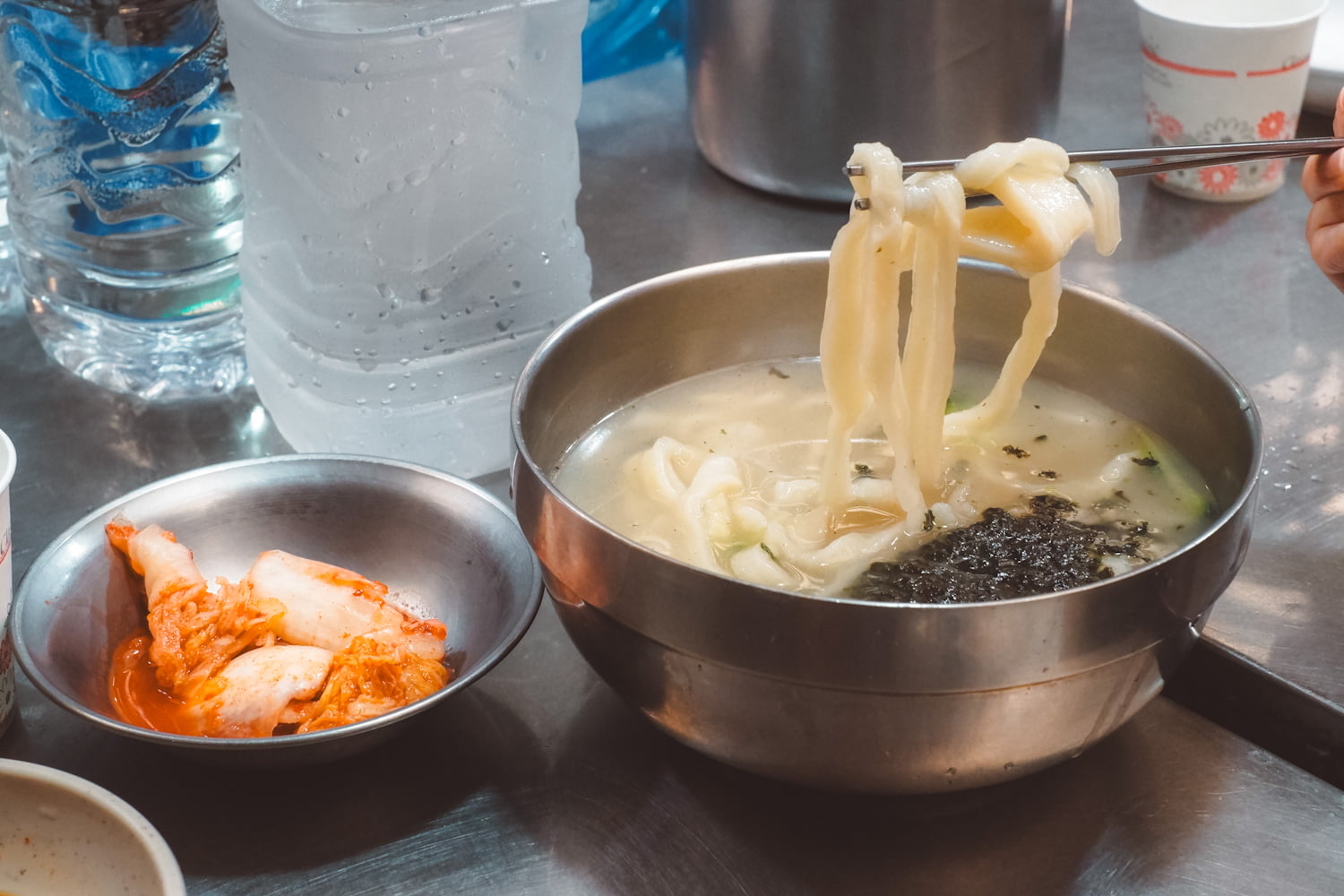
Kalguksu may ring a bell if you’ve watched the popular Netflix series “Street Food,” particularly the episode highlighting Seoul’s renowned Gwangjang Market. However, if you’re not familiar with it, let me introduce you to this delightful culinary creation. Kalguksu features handcrafted wheat flour noodles that are skillfully cut with a knife. Served in a generous bowl, these noodles are accompanied by a flavorful broth and an array of complementary ingredients.
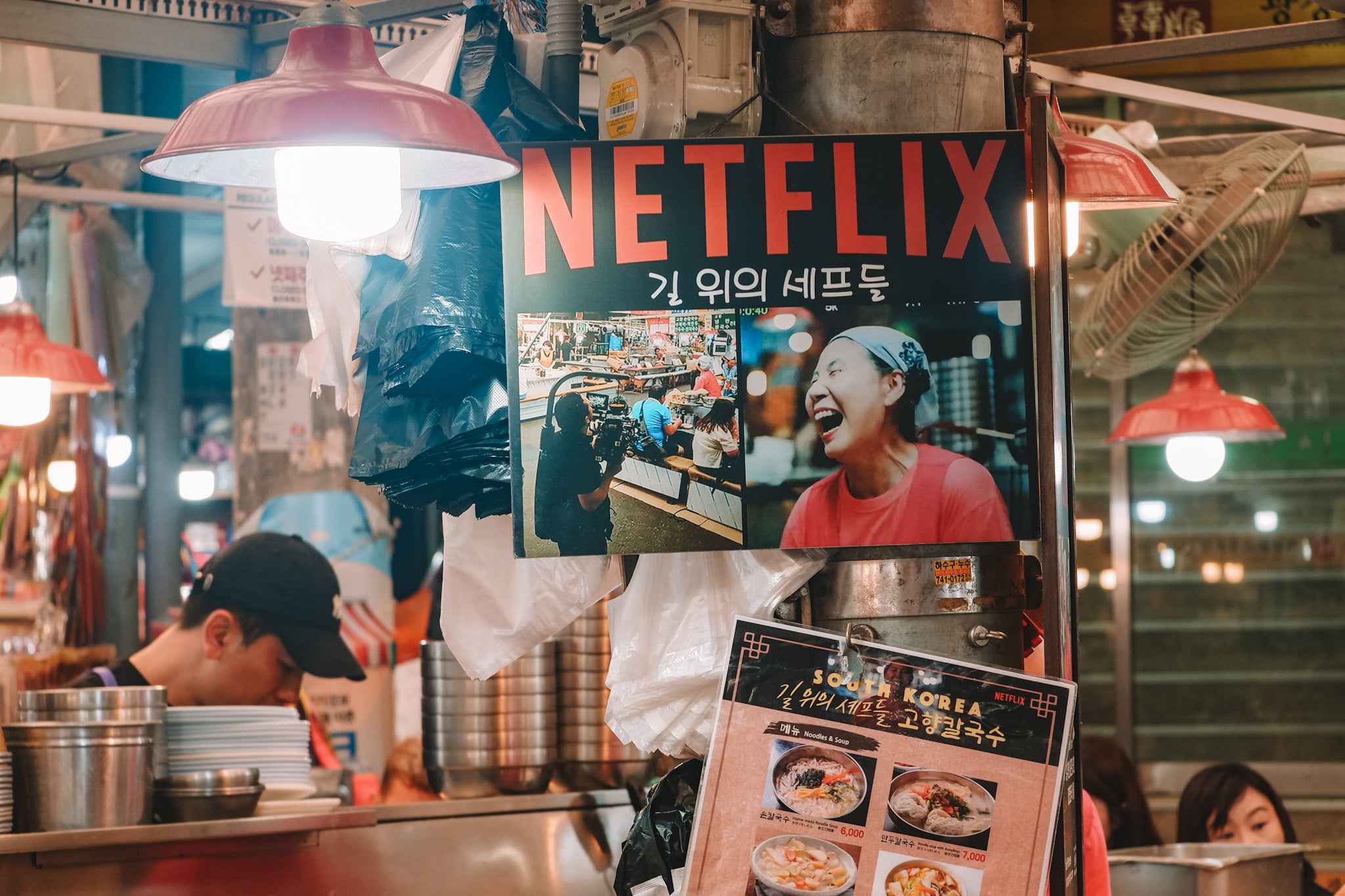
Recommended Kalguksu Places:
Janchi-guksu | 잔치국수
Type: Main Dish
Prices/Bowl: 4,000KW~6,000KW
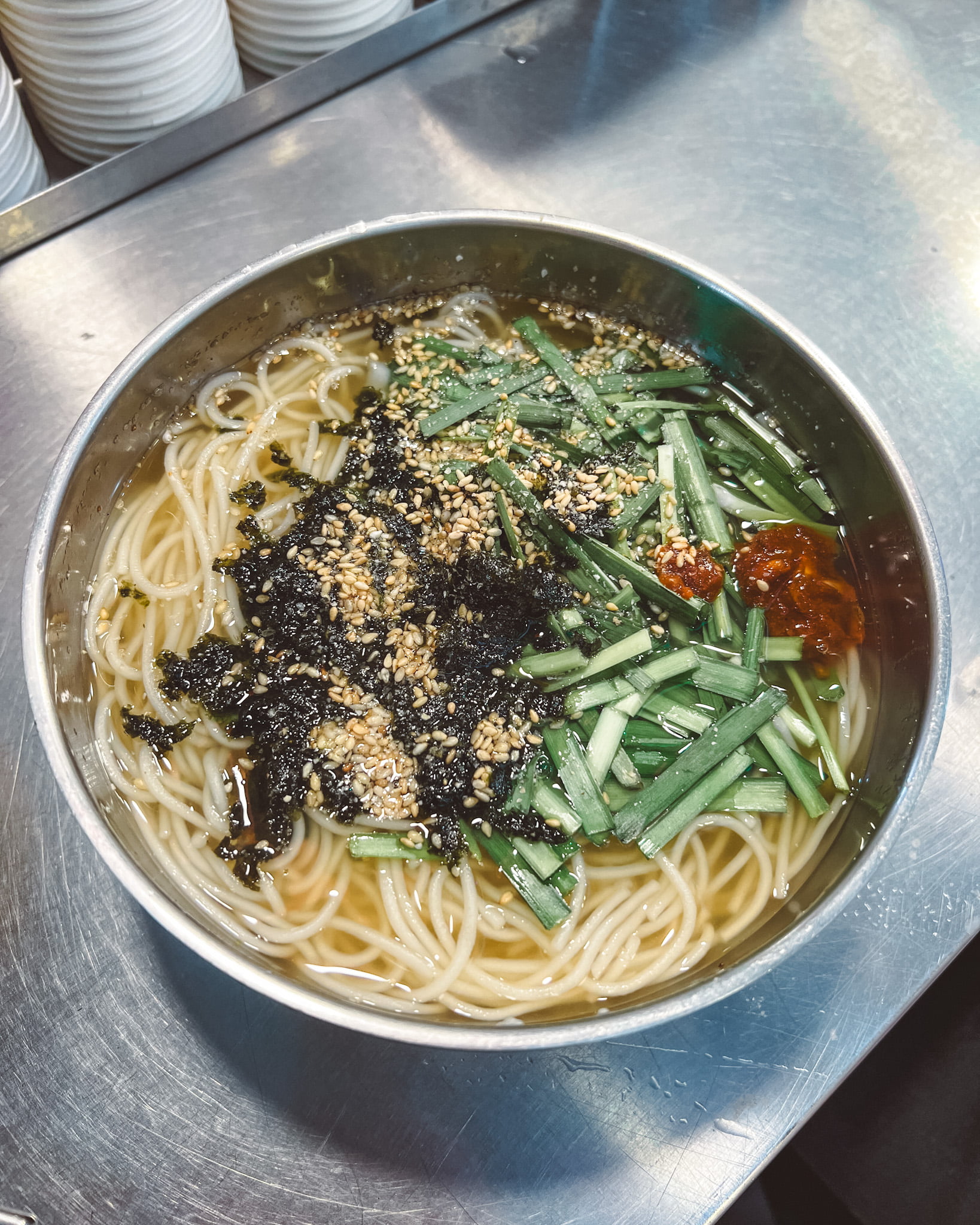
Janchi-guksu, also known as banquet noodles, is another fantastic noodle dish in Korea that’s worth trying. It features yummy wheat flour noodles in a light broth made from anchovies and sometimes dasima (sea kelp). If you’re not a fan of anchovies, you can go for beef broth instead. To add some extra flavor, it’s served with a sauce made from sesame oil, ganjang (soy sauce), a hint of chili pepper powder, and scallions. Trust me, this bowl of goodness is one of my all-time favorites, perfect for any occasion when you’re in the mood for something filling and delicious.
Recommended Janchi-guksu Places:
Hotteok | 호떡
Type: Dessert
Prices/Piece: 1,500KW~2,000KW

Hotteok is one of the many mouthwatering delights I would exclusively enjoy from the vendors at Gwangjang Market. Trust me, it’s worth experiencing here before trying it elsewhere in the country. These delightful filled pancakes are fried on a greased griddle using a nifty stainless steel circle with a wooden handle contraption. And let me tell you, Gwangjang Market takes the crown for the most scrumptious Hotteok I’ve come across so far. If you’re a fan of creamy red bean goodness, go for the one with a red bean filling. Alternatively, if you’re seeking an explosion of flavor with a playful texture, opt for the classic combination of peanuts and cinnamon. Either way, you’re in for a delightful treat!
Recommended Hotteok Places:
Yukhoe & Sannakji | 육회 & 산낙지
Type: Snack
Prices/Plate: 30,000KW~35,000KW

Yukhoe & Sannakji, a menu for the adventurous, certainly falls into the category of daring eats in Korea, considering its initially intimidating appearance. Yukhoe features thinly sliced raw beef marinated to perfection, while Sannakji showcases Korea’s infamous dish of wriggling small octopus cuts. When served together, Yukhoe & Sannakji offers a smaller portion of Yukhoe accompanied by a proper portion of Sannakji, making it an exciting choice for those brave enough to tackle these two bold Korean delicacies simultaneously. Of course, you can also opt for separate dishes of each. Many restaurants that feature Yukhoe & Sannakji on their menus also offer individual options of each dish for those seeking a less daring culinary experience.
Yukhoe & Sannakji Places:
Mandu | 만두
Type: Snack/Side
Prices/6~8 piece: 5,000KW~6,000KW
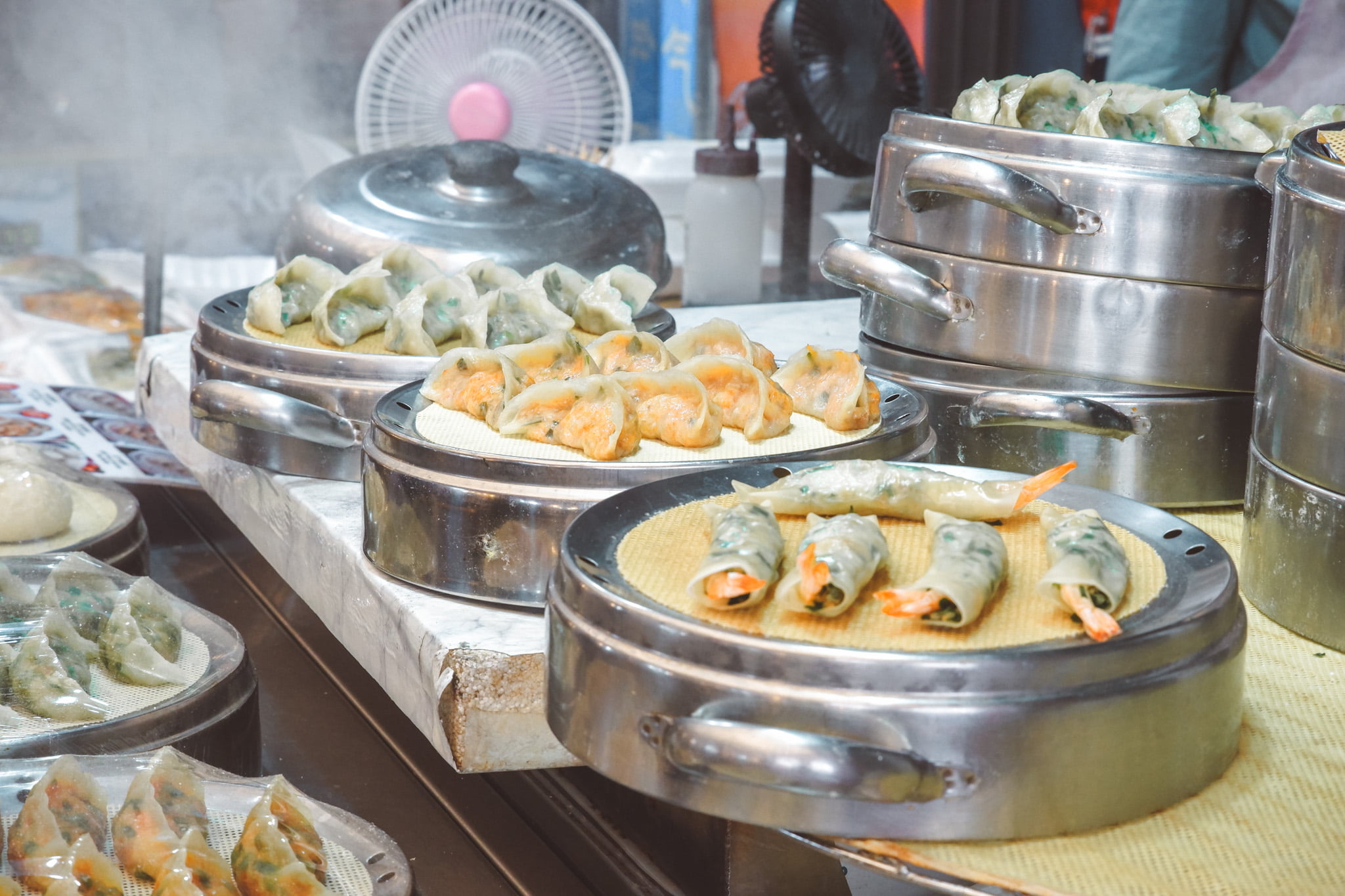
Mandu, also known as mandoo, are delightful dumplings that hold a special place in Korean cuisine. These versatile treats can be enjoyed steamed, boiled, pan-fried, or deep-fried, offering a variety of flavors and textures. At Gwangjang Market, you’ll predominantly find steamed mandu or mandu served in soup bowls. They are typically sold at stalls or restaurants that specialize in noodle dishes like Kalguksu and Janchi-guksu. Don’t miss the chance to savor these scrumptious dumplings during your visit to the market!
Recommended Mandu Places:
Tteokbokki | 떡볶이
Type: Snack/Side
Prices/Plate: 3,000KW~4,000KW
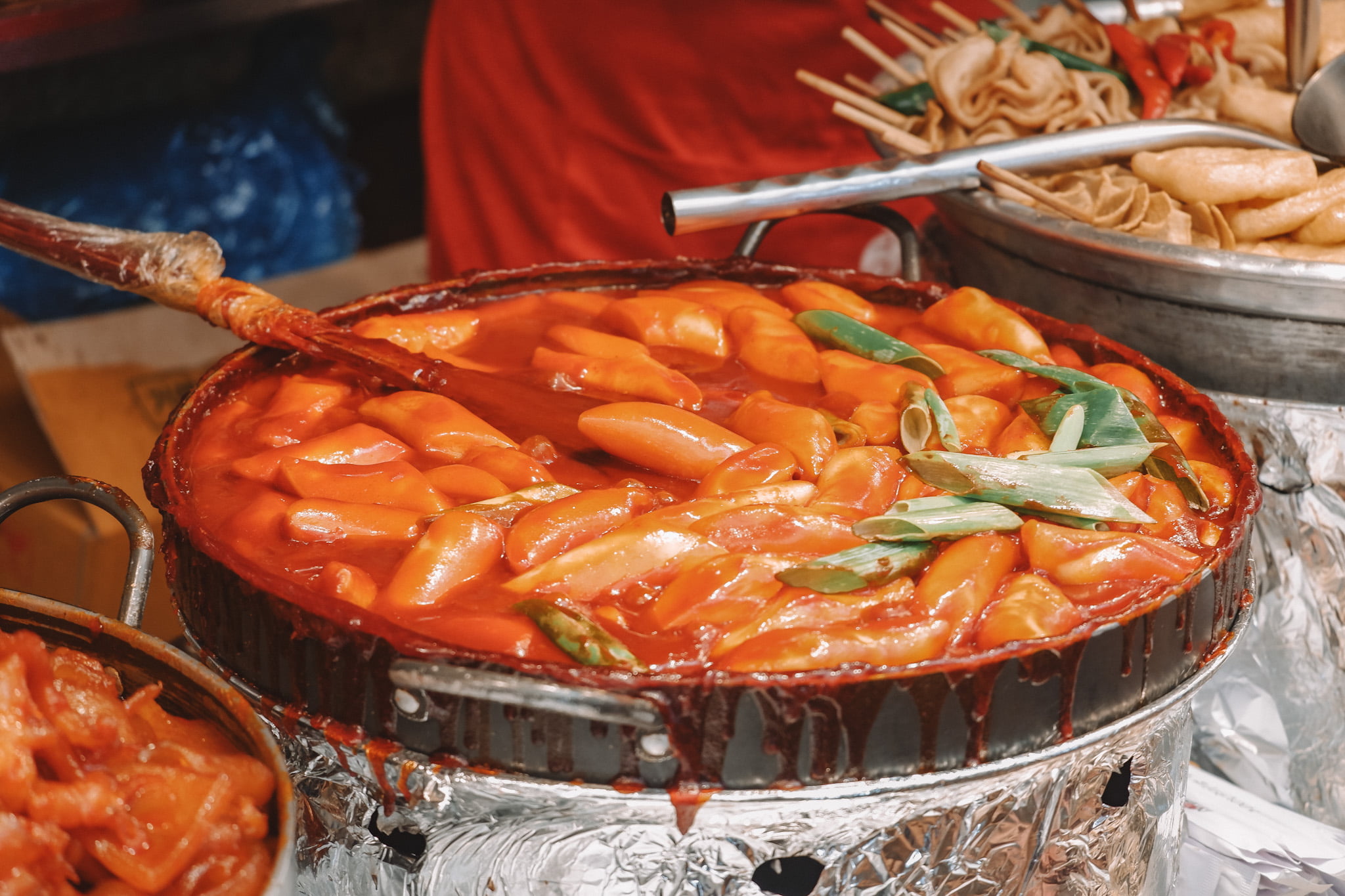
Tteokbokki, a beloved street snack in Korea, is a must-try delicacy. It features small-sized garae-tteok, which are long, white, cylinder-shaped rice cakes, simmered in a flavorful sauce. Typically, Tteokbokki is prepared with spicy gochujang (chili paste) or non-spicy ganjang (soy sauce)-based sauce. However, at Gwangjang Market, you’ll discover a delightful twist. The Tteokbokki served here boasts larger garae-tteok and a more concentrated sauce, resulting in a truly satisfying and delightful taste experience!
Recommended Tteokbokki Places:
Sundae | 순대
Type: Snack/Side
Prices/Plate: 6,000KW~10,000KW
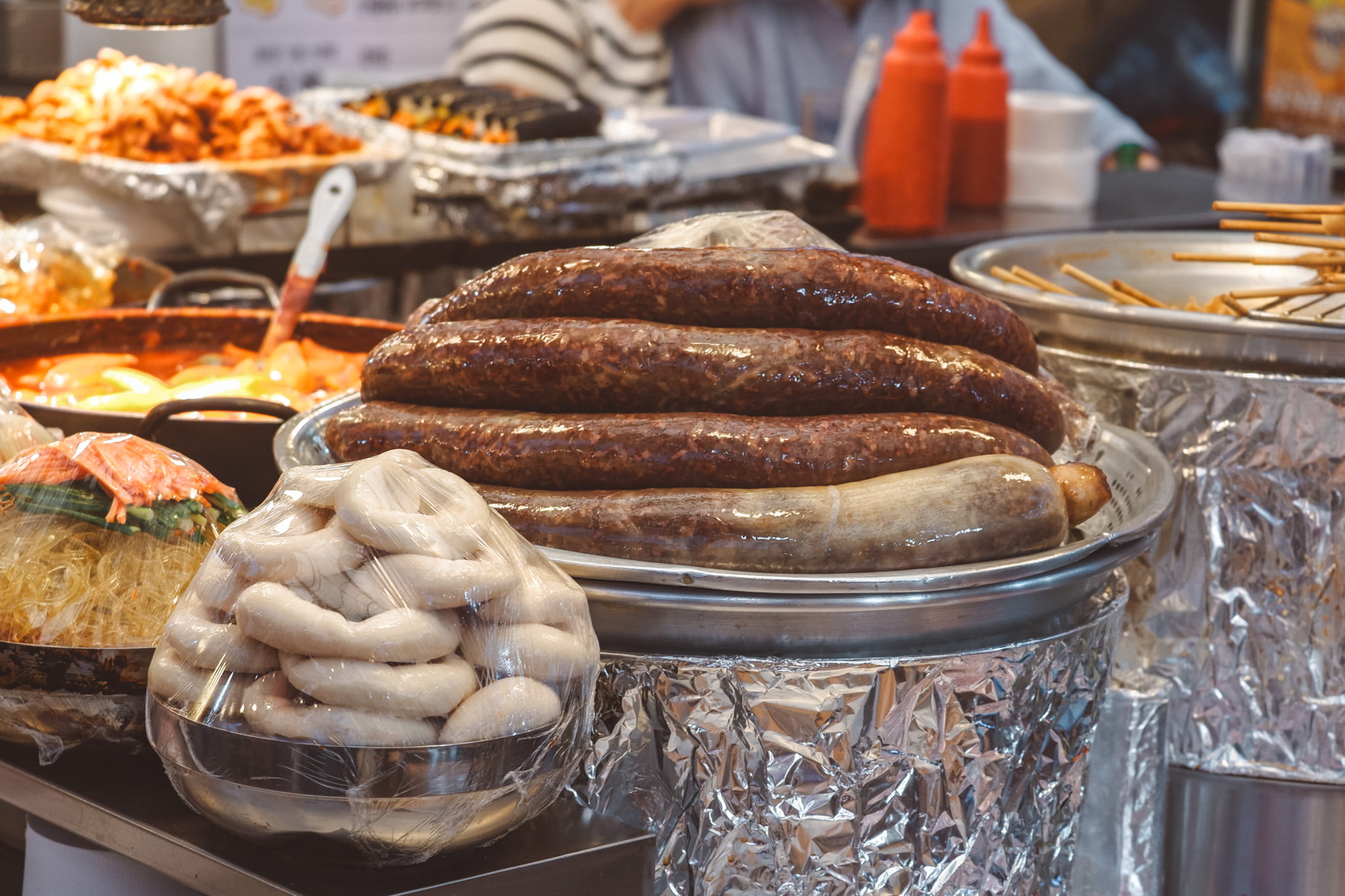
The ultimate companion to tteokbokki, sundae is a unique and flavorful dish that should not be missed. It consists of blood sausage made by steaming cow or pig intestines, which are stuffed with seonji (blood) and dangmyeon (glass noodles). Often served alongside steamed offals like gan (liver) and heopa (lung), Sundae may initially seem daunting to some due to its use of blood and entrails. However, there’s a good reason why Koreans enjoy Sundae with tteokbokki—they make the perfect pair! The delightful combination of the tteokbokki’s sweet and savory sauce perfectly complements the crunchy and springy texture of the blood sausage. Don’t let preconceptions deter you from experiencing this unique and delicious culinary duo!
Recommended Sundae Places:
Bukkumi | 부꾸미
Type: Dessert
Prices/Piece: 2,500KW
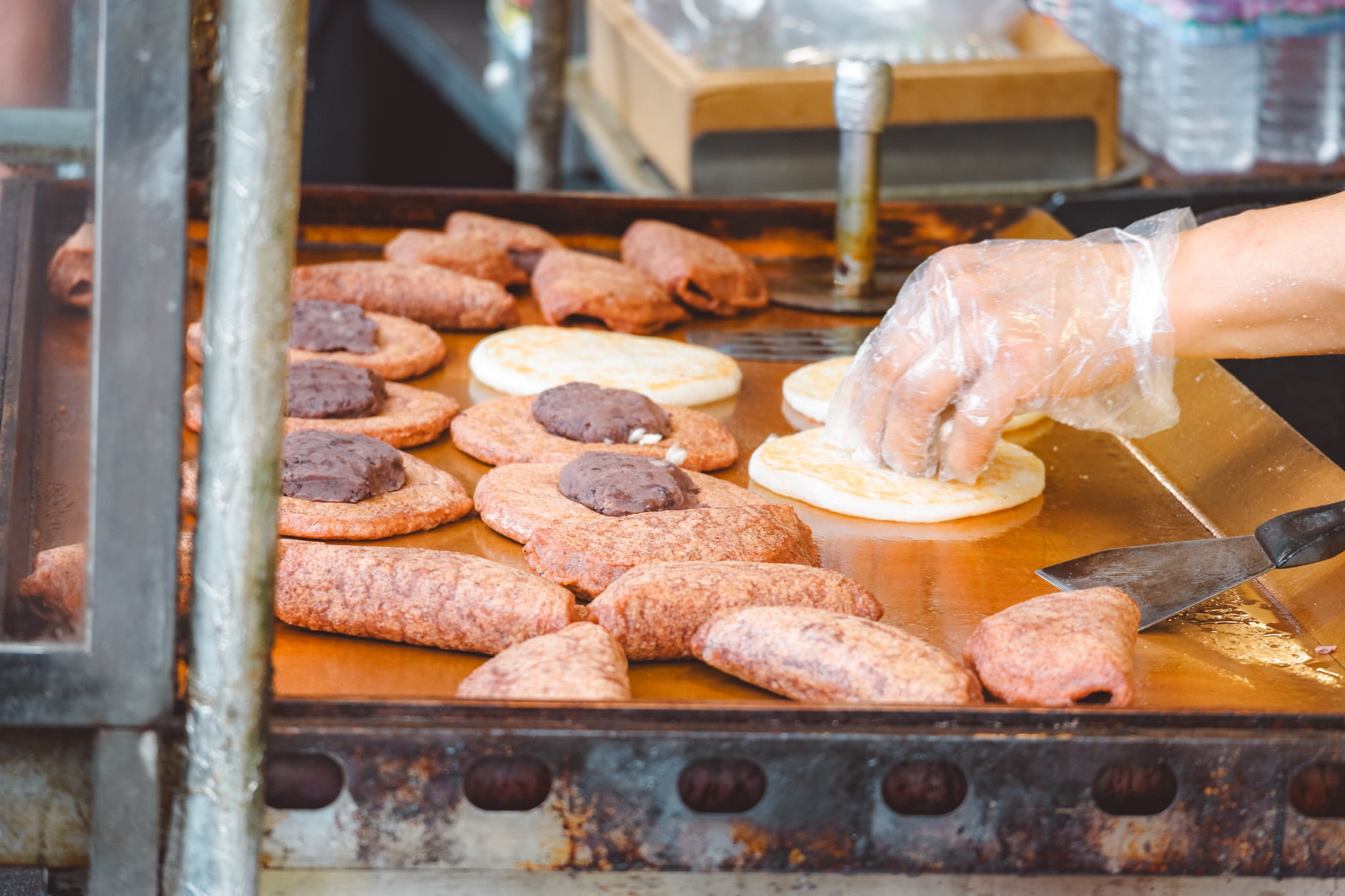
Similar to the cooking method of hotteok, bukkumi is a pan-fried rice cake crafted from either glutinous rice flour or sorghum flour. These flat, half-moon shaped cakes are filled with either white adzuki bean paste or a tantalizing mixture of toasted and ground sesame seeds, cinnamon powder, and sugar or honey. The cakes come in a range of colors, spanning from white to yellow, pink, or even dark green. To enhance their sweetness, bukkumi is often coated with honey or syrup, and adorned with shredded chestnuts, jujube, or rock tripe.
Recommended Bukkumi Places:
Sikhye | 식혜
Type: Dessert
Prices/Cup: 2,500KW~4,000KW
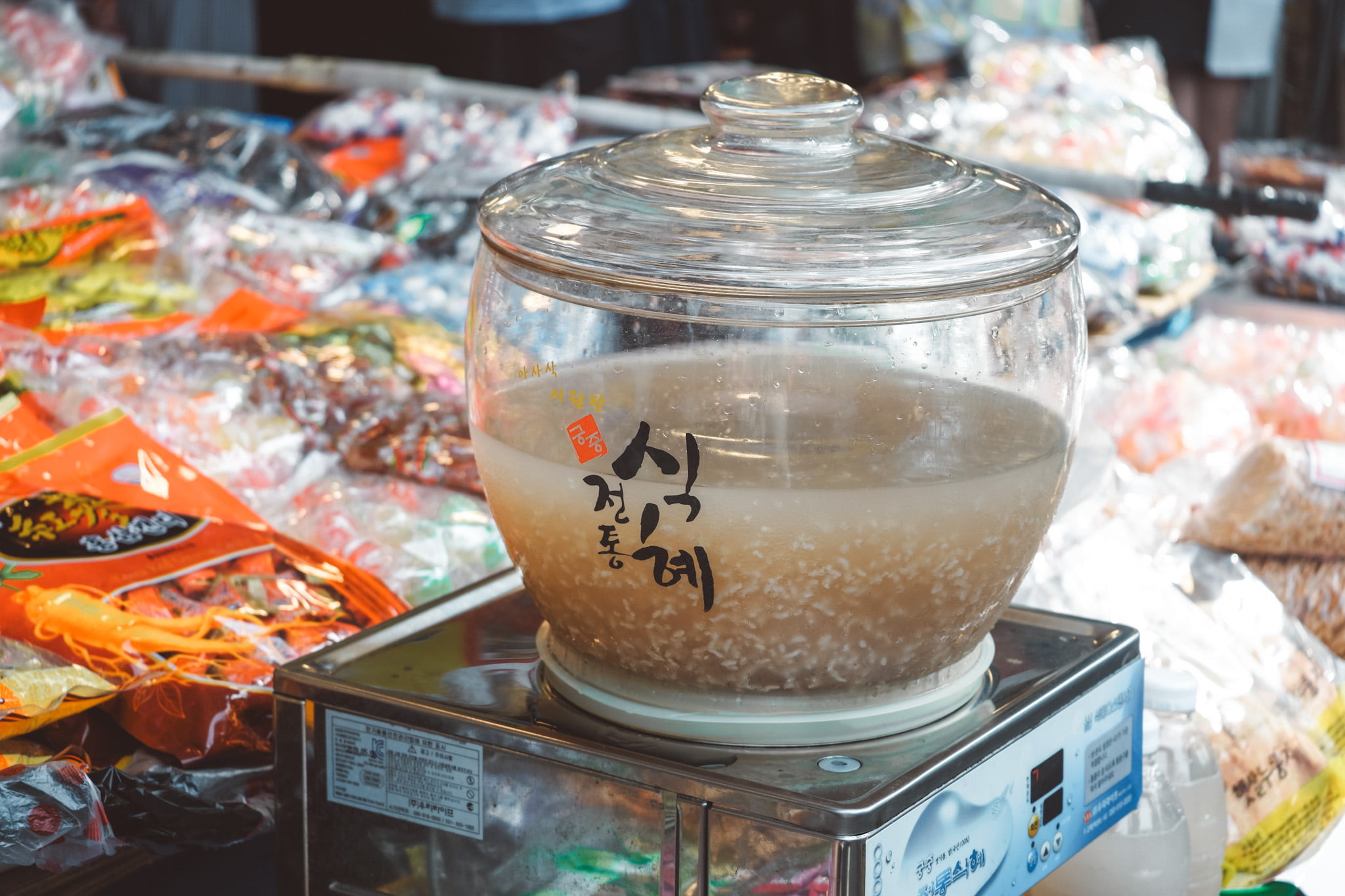
Sikhye, a beloved traditional Korean rice beverage, is a delightful sweet treat that is particularly enjoyed during the summer season. Served chilled, this refreshing drink combines liquid ingredients with cooked rice grains, and sometimes even pine nuts. With its soothing and pleasant taste, Sikhye makes for a perfect dessert option. When exploring Gwangjang Market, keep an eye out for vendors selling bukkumi or hotteok, as they often have circling machines offering this delightful beverage. You’ll most likely come across these vendors near the market’s north gate 2, creating a convenient and enticing spot to savor a cup of Sikhye.
Maeun-tang | 매운탕
Type: Main
Prices/Pot (for 2 people): 25,000KW~35,000KW
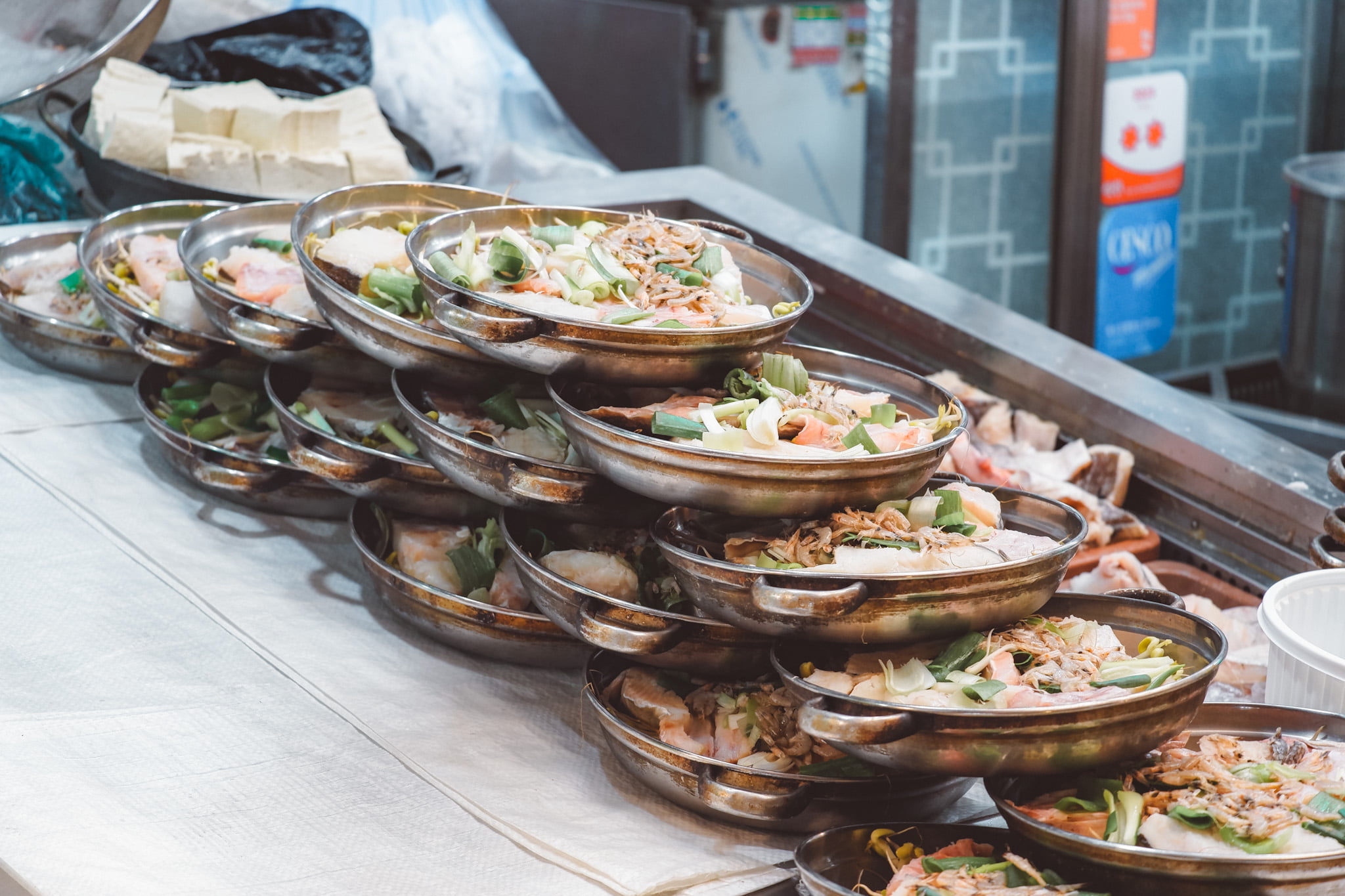
Maeun-tang, a fiery and flavorful fish soup, derives its name from the combination of two words: ‘maeun (매운)’, meaning “hot and spicy,” derived from ‘manta (맵다)’, and ‘tang (탕)’, which translates to “soup.” The main ingredient in maeun-tang is seawater fish, resulting in a rich and spicy broth. Despite its appearance as a comforting winter dish, maeun-tang is actually popularly consumed during the summer months, as Koreans embrace the belief that “heat beats heat.” When visiting Gwangjang Market, be sure to explore a particular alley dedicated to savoring this hearty cuisine. You can easily access it from the market’s north gate 1.
Recommended Maeun-tang Restaurants:
Al-tang | 알탕
Type: Main
Prices/Pot: 9,000KW~25,000KW
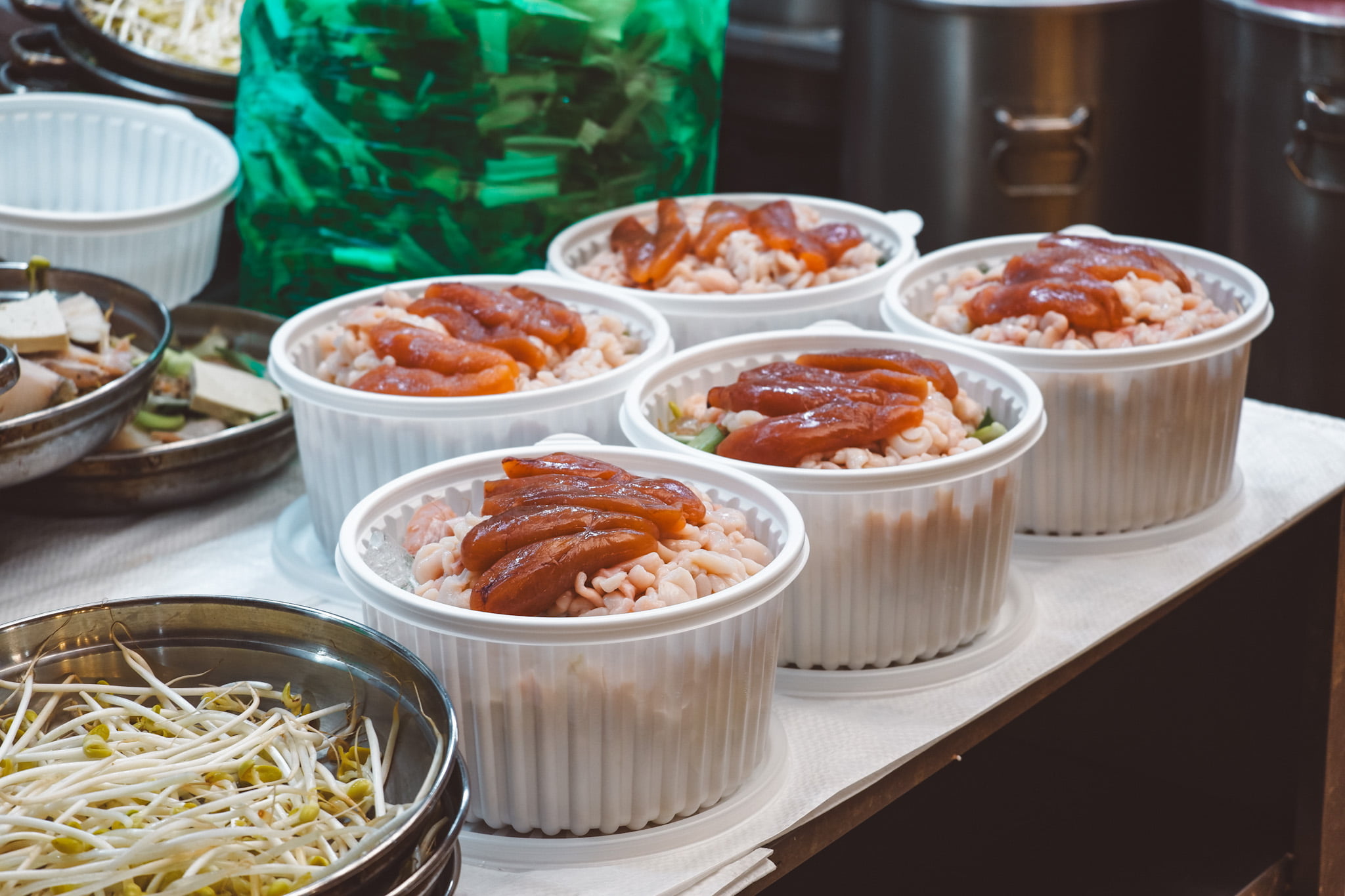
Al-tang, the sister dish of maeun-tang, shares many similarities, but with one delicious twist—the main ingredient is roe instead of fish flesh. While it may appear daring at first glance, this hot pot option is surprisingly comforting and perfect for nursing a hangover. Don’t let its initial impression fool you, as al-tang offers a soothing and satisfying experience that will leave you feeling refreshed!
Recommended Maeun-tang Restaurants:
Jeon | 전
Type: Snack/Side
Prices/Set: 10,000KW~20,000KW
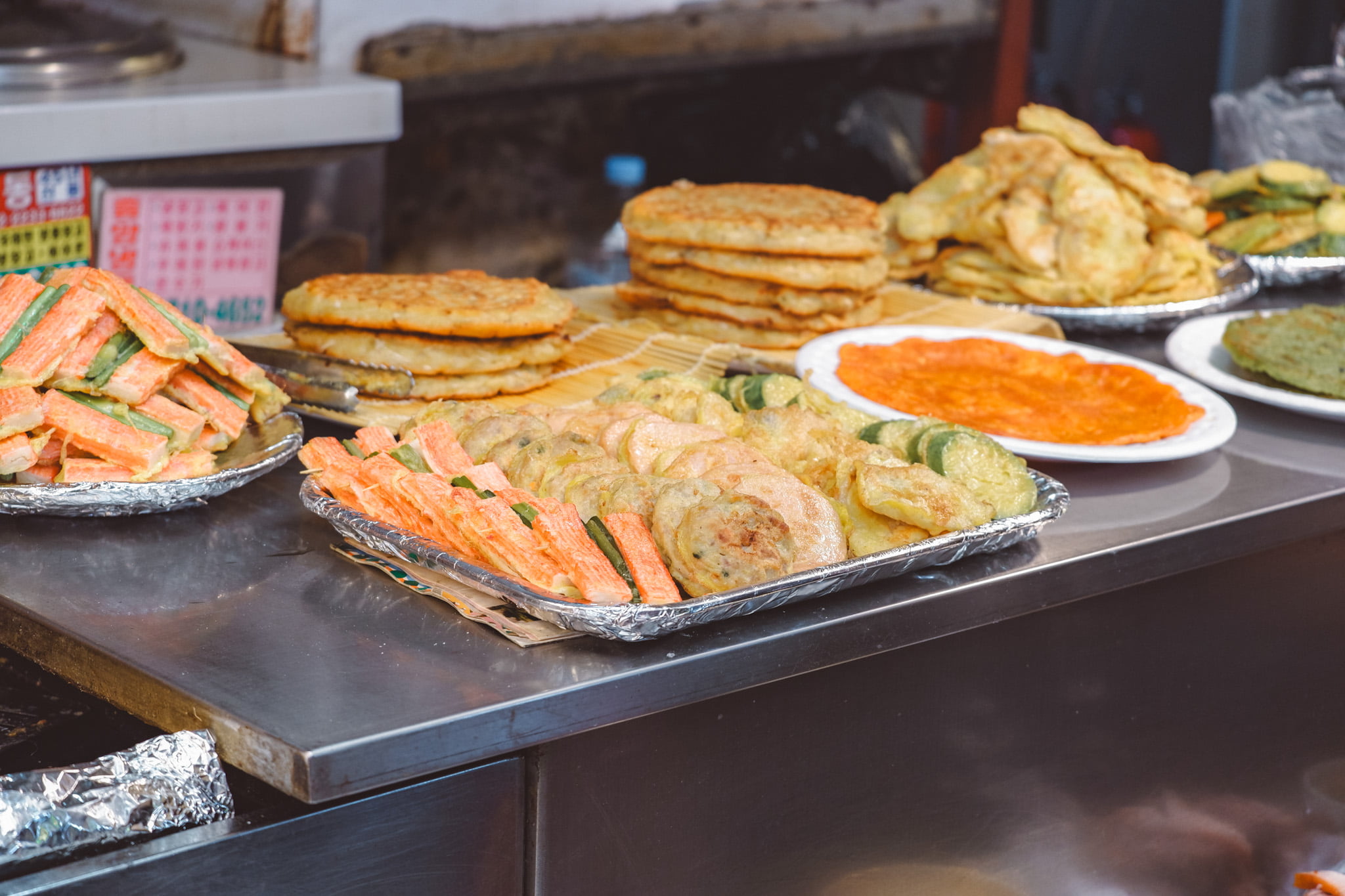
Jeon, a delightful Korean fritter, is a staple food found throughout Gwangjang Market. In fact, there’s even a special area dedicated to this delicious treat called Gwangjang Market Jeon Alley (광장시장전골목). Here, you’ll discover a wide array of food stalls and restaurants offering a variety of jeon options. To enhance your jeon experience, many of these places also serve makgeolli (막걸리), a traditional Korean rice wine that perfectly complements the flavors of the menu. Make sure to explore Jeon Alley and try some delicious settings of jeon!
Dwaejikkolijjim | 돼지꼬리찜
Type: Snack/Side
Prices/Plate: 9,000KW~15,000KW
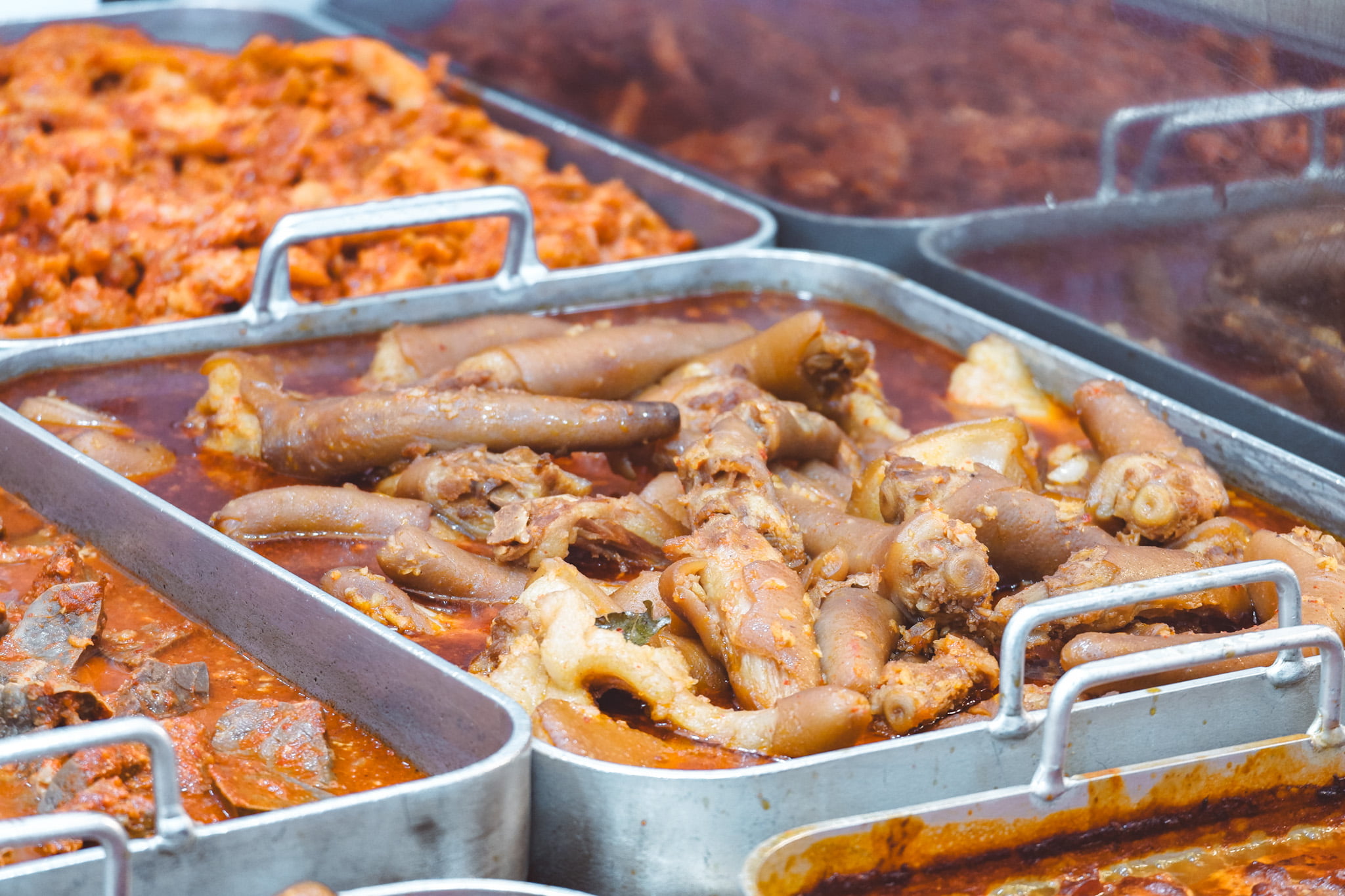
Dwaejikkolijjim, a dish of braised pig’s tail cooked with a blend of soy sauce, ginger, garlic, and rice wine, is a unique find in Korean cuisine. It’s not something you come across every day while traveling in Korea. However, thanks to the vibrant atmosphere of Gwangjang Market, you can easily discover and indulge in this daring drinking snack (안주). Alongside dwaejikkolijjim, you’ll find other braised delights that perfectly complement your alcoholic beverages. These include braised pork skin (돼지껍데기), chicken gizzard (닭모래집), beef lung (소 허파볶음), and pig leg (족발).
Recommended Dwaejikkolijjim Place:
Japchae | 잡채
Type: Snack/Side
Prices/Plate: 4,000KW~5,000KW
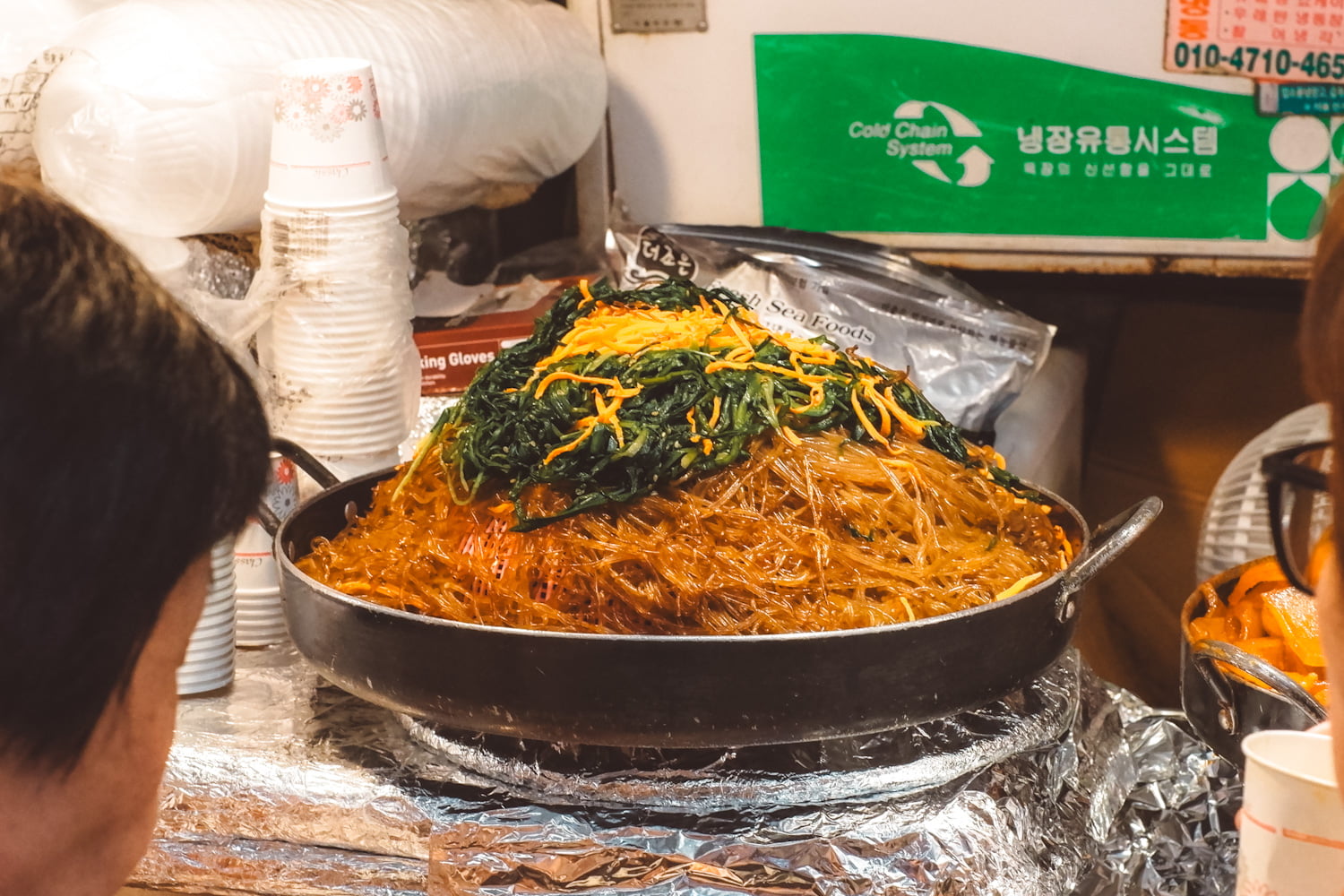
Japchae, a delicious and slightly sweet dish, features stir-fried glass noodles and a medley of vegetables. While it is commonly served as a banchan (side dish), it can also take center stage as a satisfying main course. When enjoyed as a meal, it pairs wonderfully with a piping hot bowl of rice. In Gwangjang Market, you’ll find japchae available as a snack or side dish, often in establishments that specialize in rice-based dishes like mayak gimbap. It might sound like a carb overload, but trust me, you won’t regret giving it a try!
Recommended Jabchae Places:
Dakbal | 닭발
Type: Snack/Side
Prices/Plate: 10,000KW

Dakbal, another beloved Korean anju (food paired with alcohol), is a tantalizing dish featuring chicken feet cooked through grilling or stir-frying with spicy chili sauce. While there are variations with bones, it’s the bone-free version that is commonly found in Gwangjang Market, delivering the authentic dakbal experience.
Recommended Dakbal Places:
Gochu Twigim | 고추튀김
Type: Snack
Prices: 6,000KW~10,000KW
Gochu Twigim holds the top spot as my favorite among Korean-style tempuras. This delectable dish features a gigantic green pepper, filled with savory goodness, coated in a crispy batter, and deep-fried to a delightful golden perfection. To my pleasant surprise, I stumbled upon a Gochu Twigim stall tucked away in a corner of the bustling Gwangjang Market. This menu item is a rarity, typically found in upscale establishments or food plazas within major department stores.
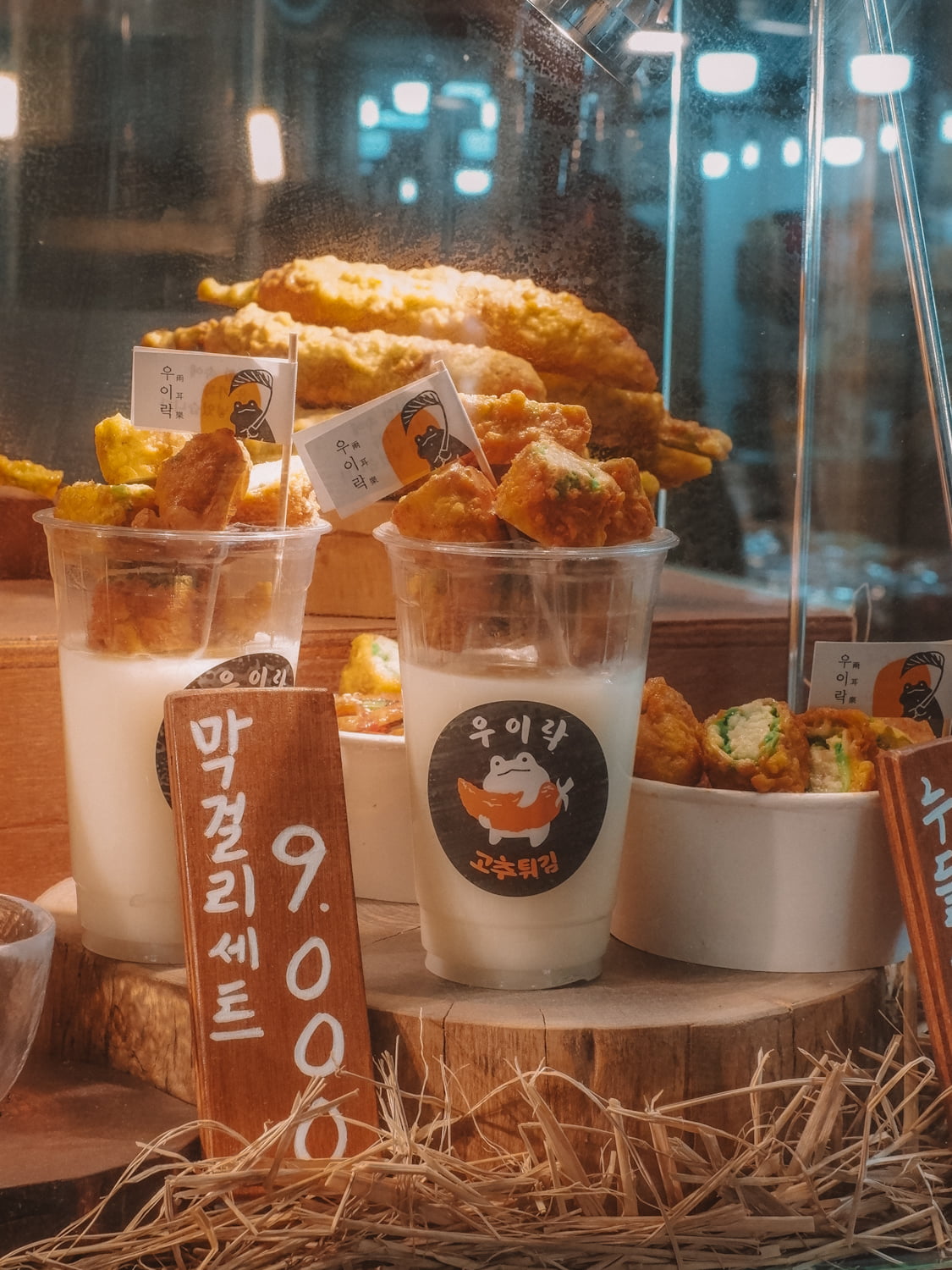
For those intrigued by this unique culinary experience and planning a visit to Gwangjang Market, I highly recommend stopping by Uirak (우이락 광장시장점). Indulge in their convenient and stylish set offering, the Makgeolli Set, which includes 1 Gochu Twigim and a refreshing glass of traditional sparkling rice wine. Priced at 9,000KRW, this set allows you to savor a delightful taste of Korean cuisine paired with a traditional alcoholic beverage—an excellent combination for your culinary adventure!
Juk | 죽
Type: Snack/Main
Prices: 2,000KW~10,000KW
Juk is a Korean porridge made by boiling rice or other grains and legumes like beans, sesame, nuts, and pumpkin. Dive into the vibrant food scene at Gwangjang Market, and you’ll discover Suwon Juk Jib, a standout spot nestled at the bustling intersection on the main street. Treat yourself to their hearty offerings, featuring flavorsome options like pumpkin or red bean porridge – a nutritional delight perfect for any time of the day!
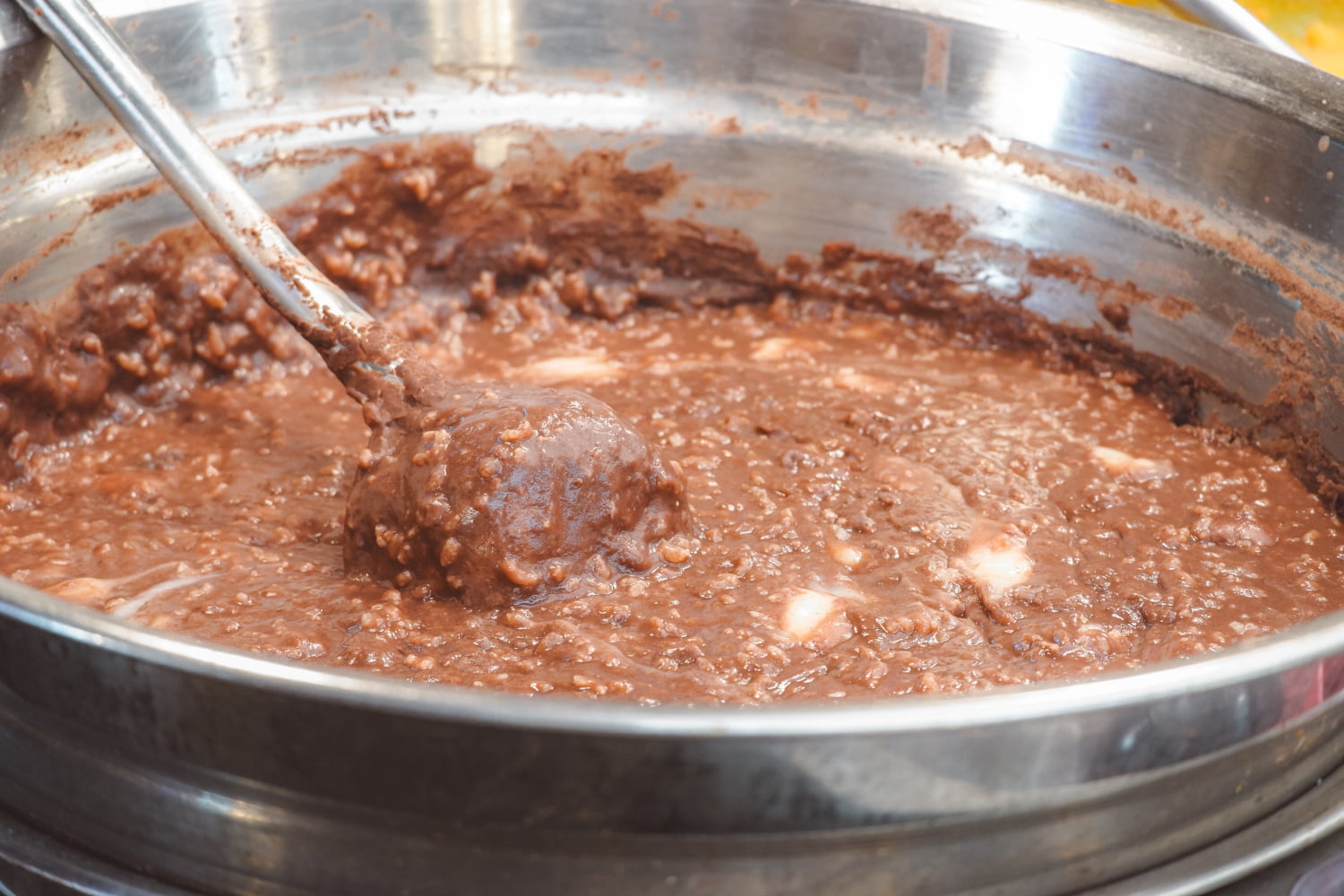
Banchan | 반찬
Type: Side
Prices: N/A

Don’t forget to swing by the textile store area of the market, where you’ll discover a delightful assortment of banchan. These side dish vendors, known as banchan-gage (반찬가게), offer a tempting selection of preserved foods that perfectly complement your meal. As you explore the array of pickled vegetables and marinated delights, keep an eye out for the captivating ganjang-gejang (간장게장) – the soy sauce-marinated raw crab that steals the spotlight. Make sure to pay a visit and treat yourself to these mouthwatering delights!
Recommended Banchan Places:
Sib-won Ppang | 십원빵
Type: Dessert
Prices/Piece: 3,000KW~4,000KW
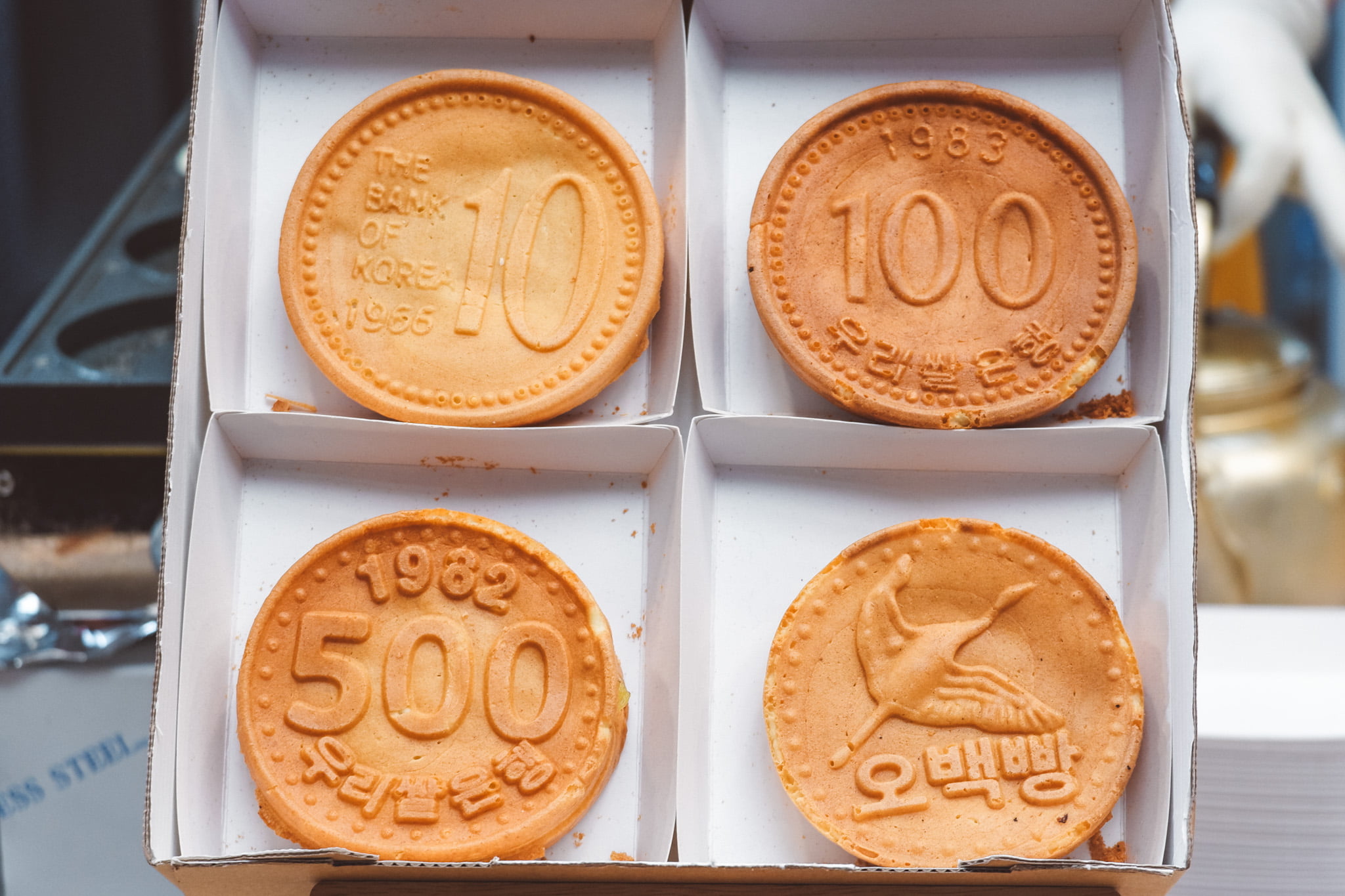
Sib-won ppang, also known as “10 won bread,” is a cheese bread shaped like a 10 won coin. Originally from Gyeongju City, it has recently gained popularity across the country. The traditional design of the bread resembles the ten-won coin that first appeared in 1966. However, today, you’ll find various sib-won ppang brands offering additional options like designs based on 100-won and 500-won coins, adding more visual appeal for those perfect Instagram shots.
Recommended Sib-won Ppang Places:
Hodu-gwaja | 호두과자
Type: Dessert
Prices/10 Piece: 6,000KW
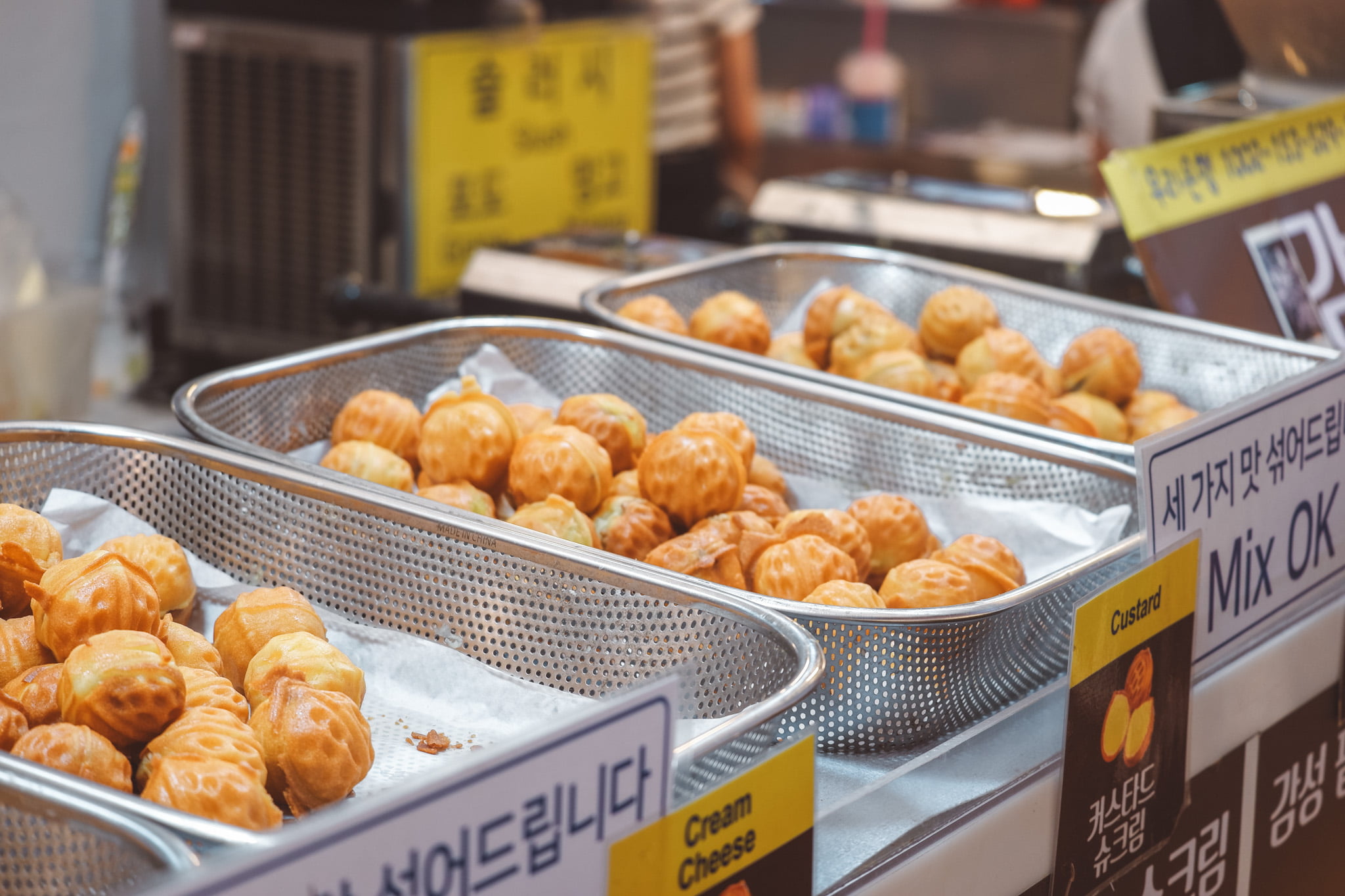
Another dessert that you can easily find in the Gwangjang Market area is hodu-gwaja, a delightful treat known as walnut cookies. These cookies not only resemble walnuts in shape but also have a dough made from ground walnuts and wheat flour. They are filled with a sweetened paste and small, delectable walnut pieces. This snack truly lives up to its name and is a must-try for all dessert lovers!
Recommended Hodugwaja Place:
Chapssal-kkwabaegi | 찹쌀꽈배기
Type: Dessert
Prices/Piece: 1,000KW
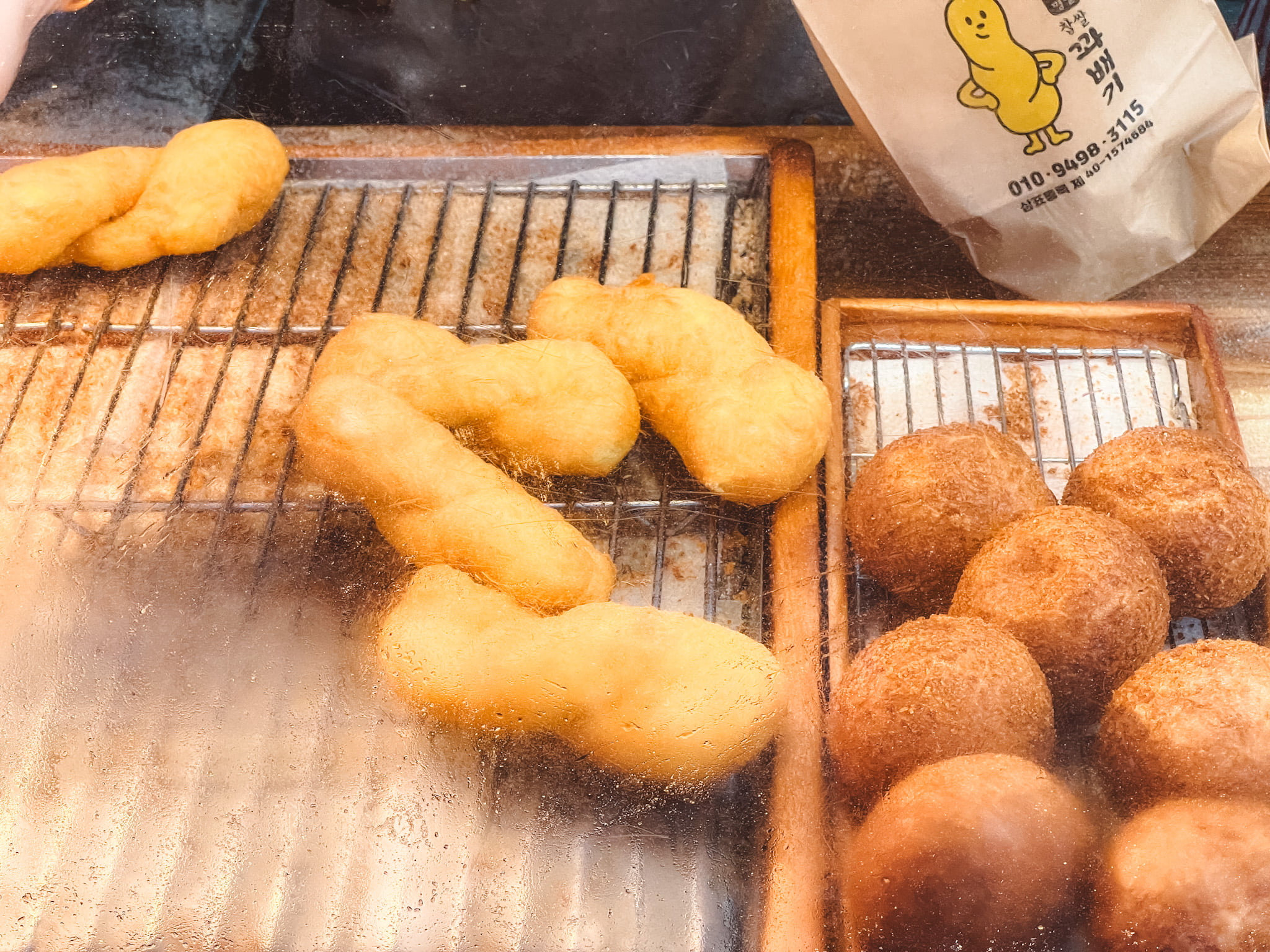
Chapssal-kkwabaegi or twisted doughnut, is a beloved snack among Korean students. Surprisingly, Gwangjang Market is home to one of the best chapssal-kkwabaegi you can find. Located near the market entrance at north gate 2, you’ll often see a long line of eager customers waiting patiently. This is a testament to the fame of Gwangjang Market Chapssal-kkwabaegi Shop (광장시장 찹쌀꽈배기), where visitors have raved about the deliciousness of the twisted doughnut. Based on numerous online reviews, the wait is truly worthwhile!
Bungeo-ppang | 붕어빵
Type: Dessert
Price/Piece: 1,500KW~2,000KW

Bungeo-ppang, a delightful dessert, takes the form of a fish-shaped pastry. Originating from the Japanese taiyaki, this treat is filled with delectable sweetened red bean paste. While traditionally enjoyed as a cold-season snack, you can savor the goodness of Bungeo-ppang all year round at Gwangjang Market. Chong-Gagne Bung-Eoppang (총각네붕어빵) is the place to be, offering a variety of fillings that defy the seasons. In addition to the classic red bean filling, this establishment is renowned for its innovative stuffing choices, which encompass cream cheese, sweet potato, and even a uniquely crafted pizza flavor!
Pastry Pizza at Café Onion
Type: Dessert
Price/Piece: 4,000KW
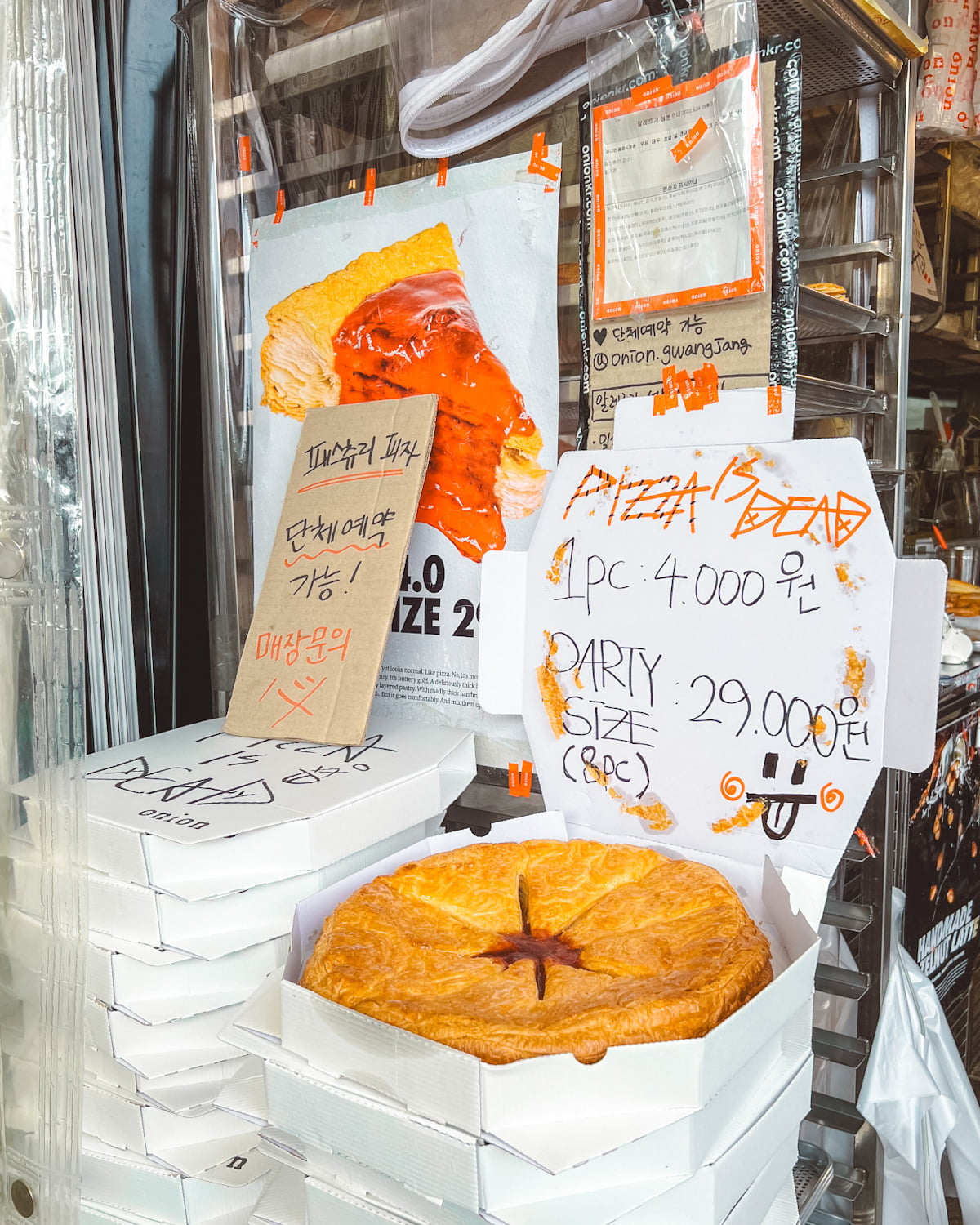
At the market’s South Gate 1, you can find another store of the famous Cafe Onion (카페 어니언). Unlike its well-known counterpart in Anguk, this branch boasts a completely distinct aesthetic. While the Anguk location showcases traditional Korean architecture, the Gwangjang outlet embraces the concept of a quaint, bygone-era house, perfectly complementing the market’s nostalgic ambiance. As you chance upon Cafe Onion’s Gwangjang Branch, be sure not to miss out on their signature offering – the Pastry Pizza. This delectable treat has captured the hearts of passersby, with its popularity evident as people pause to snag a bag or two!

In conclusion, the vibrant Gwangjang Market in Seoul offers an extraordinary culinary adventure for food enthusiasts from all walks of life. From the tantalizing aroma of sizzling bindaetteok to the sweet and delightful flavor of chapssal-kkwabaegi, this bustling market showcases the essence of Seoul’s street food scene. With this comprehensive guide, you now have a glimpse into the myriad of delectable options awaiting you at every corner. So, whether you’re a first-time visitor or a seasoned traveler, be sure to explore the diverse offerings and immerse yourself in the lively atmosphere of Gwangjang Market. Bon appétit!
Access Map:
Quick Info About Gwangjang Market:
Address: 서울 종로구 창경궁로 88
Naver Map: Link
Hours: Operating hours vary for each shop within the market
Nearest Subway: Jongno 5(o)-ga Station (Line 1) Exit 7, 8
Gwangjang Market Tour Packages:
- Seoul Gwangjang Market Unique Food Tour
- Gwangjang Market, Royal Palace, Naksan Park – Seoul Night Tour
- Seoul Night Group Tour: Gwangjang Market + Changgyeonggung Palace + Cheonggyecheon Stream + Naksan Park
- Seoul City Night View One Day Tour
Did this entry help you? Or Did you enjoy my photos? Help support my small blog by giving a little cup of joe. I am always grateful when readers reach out wanting to support 🙂
p.s. This post is independently created. However, when you book or purchase something through the retail links, I may earn an affiliate commission to help keep Ploy’s Little Atlas running. Thank you very much for your support!
p.p.s All images used (unless specified) are owned by the author of the blog and permission is required for a repost. Please, reach out via social media channels to ask beforehand if you’d like to use them.
